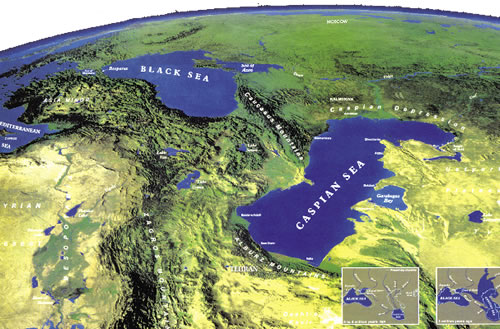ШҜЫҢШҜЩҮвҖҢШЁШ§ЩҶ Щ…Ш§ШІЩҶШҜШұШ§ЩҶ
IranвҖҷs Rights in the Caspian
- ШҜЩҠШҜЩҮ ШЁШ§ЩҶ Щ…Ш§ШІЩҶШҜШұШ§ЩҶ
- ЩҶЩ…Ш§ЫҢШҙ Ш§ШІ ШіЩҮ ШҙЩҶШЁЩҮ, 13 ШўШЁШ§ЩҶ 1393 12:25
- ШЁШ§ШІШҜЫҢШҜ: 7147
resource: Magazine events (www.events.ir); No 2 September 2003
Hoshang Tale, Ph D (Economics), Consultant Economist & Researcher
В

В
Before Peter the Great (1682- 1752) played his political games in the Caspian region, this Sea was under the sole control of Iran and was known as the Sea of Mazandaran after a northern province by the same name. Up till then nobody, no person or government, had challenged or even questioned IranвҖҷs supremacy over the Sea of Mazandaran.
Initially there were only primitive tribes living on the land known as Russia today but they were too distant and dispersed as to be considered a вҖңneighboring nationвҖқ of any significance to Iranians. Then there was Peter the Great who united these tribes and turned them into a modern nation. PeterвҖҷs reign in Russia coincided with the reign of Shah Sultan Hussein of the Safavid dynasty (1694-1722).
Peter followed an expansionist policy, which ultimately came to be known as PeterвҖҷs вҖңwill and testament.вҖқ Peter first went for the Ottoman Empire knowing that the might of Iran was too great. He was therefore very wary and
cautious with respect to Iran. Eventually he sent a number of ambassadors to the Persian Court at Isfahan, to assess the conditions prevailing in Iran. Their assessments took eight years. As it happened Peter had acceded to the throne at the right time from his own point of view: Iran was in the weakest possible state as Sultan Hussein was a simple and superstitions man and totally incapable of ruling the country.
In May 1723 Peter finally issued the order for the Russian army to attack Iran. His soldiers rushed towards Iranian territories reaching and capturing Daghestan via the Volga. They then proceeded towards Gilan by sea and occupied the city of Rasht. The local forces resisted them but were defeated.
Encouraged, the Russian army captured Badkubeh (Baku) as well. Thus, for the first time in history a foreign army attacked northern Iran by the Sea of Mazandaran and IranвҖҷs supremacy in the region was shattered. Later, however, when Peter had died and the fierce Iranian warrior, Nader Shah, was on the throne, a single warning by Nader Shah was enough for the Russians to withdraw their forces from Gilan and Caucasia.
But they remained forever in the expectation of the right opportunity to enforce PeterвҖҷs will. The opportunity presented itself when Agha Mohammad Khan, the founder of the Qajar Dynasty, was killed in the socalled Sheesheh (Glass) Citadel on 31st May 1797. The last great Iranian conqueror died at the hands of his own entourage because of his excessive cruelty.
Six years after Agha MohammadвҖҷs death the Russians once again invaded Iran (December 1803) and following a long battle that lasted 10 years or so they imposed upon Iran what came to be known as the Golestan Treaty
(12th October 1813) according to which a vast area of Caucasia, including the present day Republics of Azerbaijan and Georgia, was separated from Iran and taken over by Russia.
In Chapter 5 of this Treaty there is a passage that reads: вҖң... as regards Russian naval vessels, they are allowed to sail under their own flag in the CaspianвҖҰ and no other country except Russia has the right to have warships in the CaspianвҖқ.
Twelve years later there was another war and another treaty imposed on Iran according to which the remaining regions of Caucasia were severed from Iran and delivered to Russia and worse still IranвҖҷs supremacy over the Caspian Sea was more seriously damaged.
Fifty-three years later the Russians imposed another treaty upon Iran according to which vast areas of Central Asia, this time on the east of the Caspian, were taken away from Iran. Downfall of the Czarist Empire On 16th March 1917, Nicolas II abdicated under pressure from the Bolsheviks and, as his brother Grand Duke Michael
refused the throne, the Empire collapsed. This made Iranians very happy but soon the Revolutionary Army with its flags and emblems of the Hammer and the Sickle invaded northern Iran to help out the вҖңoppressed Iranians.вҖқ
There ensued a series of clashes which ended in the 1921 treaty by which the Russians reaffirmed the rights they claimed through inheritance from the Czars but in the process Iran managed to get better terms regarding its own rights in the Caspian. According to this treaty Iran and Russia gained equal rights in this Sea.
On 25th March 1940 an agreement was signed by the two sides regarding trade and shipping which reaffirmed
the two nationsвҖҷ equal rights to shipping in the Caspian as well as to exploiting its natural resources, fishing in
particular. In all the following correspondences between the two states the Caspian was repeatedly named as вҖңthe Sea of Iran and the Soviet Union.вҖқ In Article 13 of the Agreement one reads:
вҖңThe two sides agree that, based on the principles stated in the 1921 treaty concluded between Iran and the Soviet Union, no vessel shall sail in the Caspian except those of Iran and the Soviet Union.вҖқ
The collapse of the Soviet Union On 21st December 1991 the Soviet Union collapsed and consequently 15 new republics that were parts of the Union became independent states of which three in Caucasia and five in Central Asia had at one time been parts of Iranian territory, and had been taken away according to Golestan, Turkmanchai and Akhal Treaties (1803, 1828 and 1881 respectively). Of these newly independent states, three have coasts on the Caspian Sea: the republics of Azerbaijan, Kazakhstan and Turkmenistan. The legal status of the present Caspian Sea The only existing official documents, which define the legal status of the Sea of Mazandaran, are the two treaties of 1921 and 1940 signed by Iran and the Soviet Union.
According to these, Iran and the Soviet Union have equal, that is 50-50, rights to this Sea and its resources. Furthermore, the two agreements explicitly emphasize that:
1- The Sea of Mazandaran or the Caspian is a closed sea
2- This Sea is controlled by Iran and the Soviet Union only
3- Since no boundary has been set, the two sides own this sea commonly.
The next important point to note is that the newly independent states have undertaken, in the Minsk and Alma Ati agreements which they signed on becoming independent, to honor all of the ex-Soviet UnionвҖҷs obligations
and undertakings.
On the basis of the foregoing points it becomes evident that Russia and the newly independent states of the ex- Soviet Union all put together have rights to only 50% of the Caspian Sea. The other 50% belongs to Iran and Iran cannot and must not forego its rights to this 50% that legally belongs to it.





